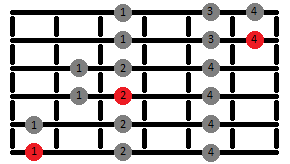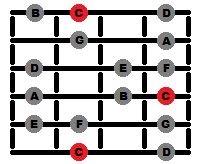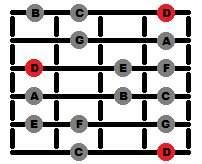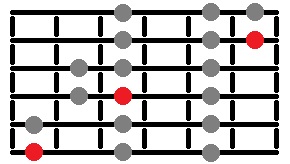Now that you know about what modes are (and totally didn’t skip through that entire post), it’s time to apply that knowledge to the guitar itself. Keep in mind, the goal of this post is to get you to begin thinking in terms of modes on the guitar. Don’t get too caught up in the theory behind it, as the post following this will bring everything together.
The beauty (or curse) of stringed instruments is that there are multiple ways to play any given scale. This is a very important concept to understand if you want to play across the whole fingerboard. Certain scales span across more frets than others, and all scales have their place. Either way, let’s take a look at one of the most common major scale patterns. Again, let’s assume the key of C.
The letter names for C major are included for demonstration purposes, but this shape can be played anywhere on the neck to play in any key.
For those of you that are confused at what you’re looking at, this is a scale diagram meant for the guitar. Imagine that the grid is your fretboard, where the horizontal lines are strings and the vertical lines are the frets. The bottom horizontal line is the low E string, then the A string, D, G, B, and finally the top line represents the high E string. The C’s are highlighted in red because they represent the root note of the scale.
As I mentioned before, if you know how to play this basic major scale, you can play ANY of those modes I mentioned in the last post. It all depends on what your starting note is.
For you visual people, I’ll highlight all the D’s in the pattern instead of the C’s. Remember, the highlighted circles are your root notes.
By playing this scale with the D’s as your root notes, you’re playing the D dorian mode. I could go on to highlight the E’s, F’s, G’s, A’s, and B’s, in order to show you the other modes, but I think you get the point. Here, let me drill it into your head even more, this time using pretty colors:
If you start the pattern from the first scale degree (in this case, C ), it’s C Ionian.
If you start the pattern from the 2nd scale degree (in this case, D ), it’s D Dorian.
If you start the pattern from the 3rd scale degree (in this case, E ), it’s E Phrygian.
If you start the pattern from the 4th scale degree (in this case, F ), it’s F Lydian.
If you start the pattern from the 5th scale degree (in this case, G ), it’s G Mixolydian.
If you start the pattern from the 6th scale degree (in this case, A ), it’s A Aeolian.
If you start the pattern from the 7th scale degree (in this case, B ), it’s B Locrian.
Got it?
Uh, alright…but I’m still playing over a span of 4 frets. Eddie Van Halen uses more than 4 frets. How can I be Eddie Van Halen with 4 frets?
Baby steps. I know all I’ve done so far is make your pleasant little major scale more complicated, but don’t worry, you’ll thank yourself for understanding this concept later. If you want to cover more frets in one scale, you’ll have to play more notes on each string. Let me introduce you to another major pattern that I personally use the most. Are you ready to stretch your fingers a little?
Side note: Whenever I learn or show someone a new scale or scale pattern, I always imagine the music from Ocarina of Time after you learn a new song on the Ocarina.

You’ve learned Dan’s Favorite Major Scale Pattern!
Sorry if you don’t get that reference. ANYWAY, the idea of this pattern is to play three notes on each string, which successfully covers a whopping six frets when played over two octaves. Again, each red circle represents the root of the scale. If you’re playing a C major scale, each red circle is a C. If you’re playing an F major scale, each red circle is an F. It all depends where you are on the fretboard. Again, all of that mode stuff applies to this pattern as well. If you start it on a D, it’s D dorian, blah blah blah.
Okay, that pattern covers more frets, but it’s annoying to play and sounds exactly the same as the first pattern!
Well, the purpose of this pattern isn’t just to be annoying and look more impressive to play. Think of this scale as the foundation, the starting point, or home base when playing across the whole fingerboard. I’ll explain in the next post, but for now I strongly encourage you to practice this scale. Here is my suggestion for which fingers to use where.

Major scale pattern with numbers to indicate which fingers to use. 1 = index finger, 2 = middle finger, 3 = ring finger, 4 = pinky.
If you aren’t used to playing scales like this, you will most likely have trouble with those first 6 notes on the bottom, where you have to stretch apart you index and middle fingers. Just keep at it and it will feel natural in time. Check the next post where I explain why this is my favorite major scale pattern, and how you can piece it together with the patterns of other modes to cover the entire fretboard!




